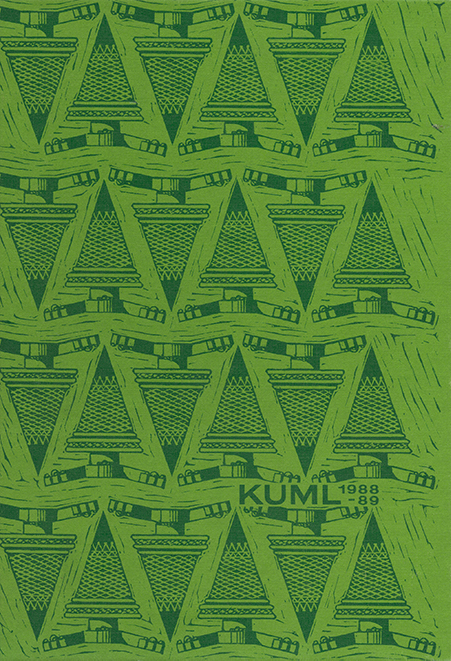A mound with a chamber-grave and other graves from the Bronze Age at Grønlund
DOI:
https://doi.org/10.7146/kuml.v36i36.110930Keywords:
Grønlund, mound, chamber-grave, bronze ageAbstract
A mound with a chamber-grave and other graves from the Bronze Age at Grønlund
In 1988 Horsens Museum excavated a relatively well-preserved mound-complex at Østbirk in eastern Jutland (figs. 2, 3). During the excavation a new measuring technique was used i.e. using photographs of the scraped mound surface taken from a fighter plane (4) (fig. 1).
The mound complex encompassed four phases (fig. 2). The oldest mound (mound I) was found on the north of the complex (figs. 1, 2, 3). the structure looked like a heap of stones with a diameter of 10 m. Large parts of the stone arrangement in the central and southern parts had been removed, probably in recent times (5).
Mound II, which was constructed of peat, was laid out concentrically around mound I, with a diameter of 16 m. The mound was encircled by a ring of large rim-stones.
In the centre of these two mounds were found two disturbed interment graves, A9, 1 and A9,2; both were probably bole-coffin graves (6). A9, 1 was probably the original reason for the construction of mound I. This grave contained a long-handled dagger of bronze (figs. 4+5). The dagger dates the grave to Period I of the early Bronze Age (7). Grave A9,2 was dug down through the north side of A9,1, and was therefore clearly the later of the two. Apart from a small fragment of a bronze arm-ring this grave contained no artefacts. It is probable that this grave was the cause of the extension of the mound which comprised mound II.
Mound III was built against the south side of the two earlier mounds (fig. 6), so that the structure had common rim-stones to the north, while the rest of the almost ellipse-shaped mound, 27-28 m long and 16-18 m wide, was surrounded by a substantial independent ring of rim-stones. The reason for this extension of the mound was grave A1, which was situated in the southern part of the mound. The grave proved to be a rectangular stone frame, 4.5 m long and 3.2 m wide, east-west in axis, with rounded corners (figs. 7, 8). At a depth of about 50 cm the grave-area was found; it had been a small plank-coffin 1.3 m long and 1 m wide (8). There was no trace of the dead body, but at the west end of the grave, only 10 cm from the gable, a small group of artefacts was found, consisting of a bronze dagger in a wooden sheath (fig. 10), a razor (9), and a flat-carved flint-dagger/crozzle (fig. 9). the artefacts date the grave to period II of the early Bronze Age. When the stone frame around the grave area was removed, traces became visible of a 3.5 X 2.3 m structure which undoubtedly was the remains of the foundations of a major post-and-plank built chamber (figs. 11, 12). The structure consisted of four substantial stone-lined corner post-holes (10) and between them a ditch, ca. 20 cm wide, which continued at the gables round the outer sides of the postholes. There was no trace of wood in the structure, but instead there was firm and homogeneous mould-fill, which indicates that the building was taken down a relatively short time after it had been erected.
The latest of the mounds on the site, mound IV (fig. 13), encompassed the three older ones, with a diameter of 32-34 m. the mound was built of peat and surrounded by a substantial ring of rim-stones. Grave A2 can with reasonable certainty be associated with this mound-phase. the grave, a full adult-length »burnt-bone-coffin« (fig. 14), contained the burnt bones of a woman (11) and a hiltplate dagger of bronze (fig. 15). The grave-type and the dagger date the grave to period IV of the late Bronze Age. The chamber-grave A1 in mound III is by far the most interesting of the structures. Chamber-graves of this type only recently became known and belong to a probably small group of graves (5 are known) from the middle of the early Bronze Age (period II).
The graves of this type can be split into two groups: on one hand, chamber-graves with sizable corner-posts, and on the other, chamber-graves without corner-posts. Common to the two types are traces of solid plank-built walls.
The chamber-graves with corner-posts have been found in three places: Herlev (12), Vejrup (13) and Grønlund A1. The Herslev (fig. 16) and Grønlund chambers are the most similar, while Vejrup (fig. 17) is considered to be a special type with double post-holes and possibly an opening to the south.
The chamber-graves without corner-posts are known from two cases: Bredhøj grave B (14) (fig. 18), and Ebeltoft Færgehavn (15+16) (fig. 19). These two graves are distinguished by substantial plank-built walls and can most accurately be described as an intermediate form between the solid post-built chambers and the less substantial plank coffins.
Chamber-graves are rare. Since this is a matter of structures which cannot easily be overlooked, the number found can be assumed to reflect fairly realistically their actual occurence. Why an evidently very small minority of the population was buried in a different way from the majority cannot be determined from the small quantity of material available.
Orla Madsen
Horsens Historiske Museum
Downloads
Published
How to Cite
Issue
Section
License
Fra og med årgang 2022 er artikler udgivet i Kuml med en licens fra Creative Commons (CC BY-NC-SA 4.0).
Alle tidligere årgange af tidsskriftet er ikke udgivet med en licens fra Creative Commons.


